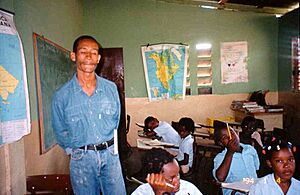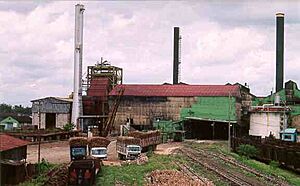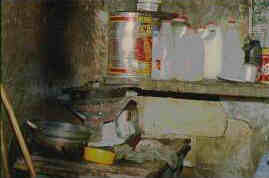Batey (sugar workers' town) facts for kids
A batey (say "bah-TAY") is a small community built around a sugar mill. You can find these settlements in countries like Cuba, the Dominican Republic, and Puerto Rico.
In Cuba and the Dominican Republic, a sugar production center is often called an ingenio. An ingenio includes many parts. It has a main office, a sugar cane mill, and a sugar refinery. It also has the town where people live, large fields of sugar cane (called campos de caña), and equipment like trucks and trains. The homes for the workers are usually in a special area called a batey.
A batey is like a company town. It has simple homes or barracks for workers. Bateyes can be very different in size. They are always located close to the cane fields. This way, workers can live near where they do their hard work.

Bateys in the Dominican Republic
Since 1933, many seasonal immigrants from Haiti have come to the Dominican Republic. They arrive each year to help with the sugar harvest. These workers live in rooms in the batey. Sometimes, these rooms do not have many facilities. Workers are expected to cut sugar cane for many hours each day.
Today, sugar mills and land owners often pay people called buscones (headhunters). These headhunters find cane cutters (picadores) for them. A headhunter might promise a work permit to a worker. They often ask for a large payment from the worker. When immigrants arrive, they might find they cannot leave the batey until their work is done.
Over time, some of these workers have stayed longer than the six-month harvest season. This time is called "dead time" (tiempo muerto). They have started families with Haitian women who also moved there. Bateys have a special culture and language. They are a mix of Haitian and Dominican traditions.
The Dominican government has not always provided many public services to bateys. This is less than what other towns of similar size receive. Bateys were often seen as illegal settlements. They were not always included in the country's main system of government. It was often up to the State Sugar Council (CEA) or private companies to provide basic services. However, they often did not do this. Bateys were often thought of as places where only Haitians lived, and Haitians were not considered citizens.
Many Haitians who first came to the bateys were not legal immigrants. Because of this, their children often could not get citizenship papers. This was because they were seen as being born while their parents were just passing through. Without citizenship papers from Haiti either, these children could not go to school. They also could not get other public services. However, some non-governmental organizations have started primary schools in bateys. They also try to help these children get Dominican citizenship.

In the past, making sugar was a very good business. But now, the sugar industry in the Dominican Republic is not as strong. Also, bateys have historically lacked good schools and health services. The wages for workers are very low. This has made bateys some of the poorest communities in the country.
Now, many sugar mills in the Dominican Republic are stopping production. This means the main source of income for these communities is gone. Because of this, bateys are slowly changing into new kinds of communities. For example, Los Alcarrizos in the Santo Domingo province used to be a batey. Now, it is a municipality where people find jobs in the local area and in Santo Domingo. Workers in bateys often face very difficult conditions. They are paid very little for long hours of hard work. They may live without electricity or running water.
See also
 In Spanish: Batey para niños
In Spanish: Batey para niños




